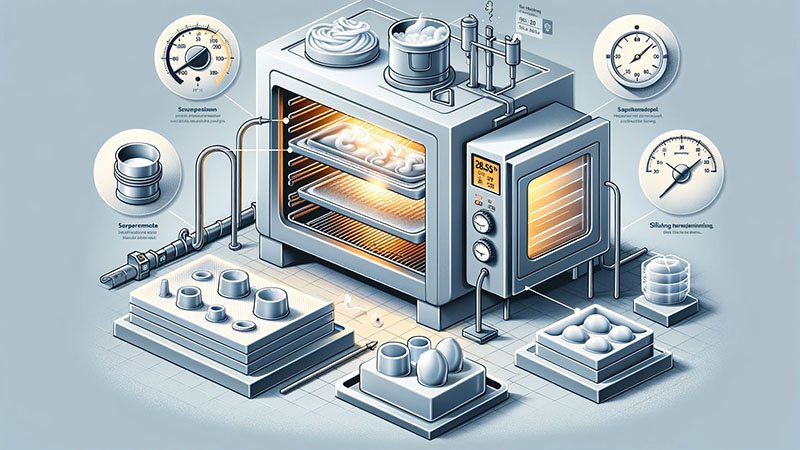Enhancing silicone’s properties is key to boosting its performance and longevity in various uses. Annealing is one such technique, yet many are unfamiliar with what it involves and how it benefits their products. This blog will delve into silicone annealing, its advantages, and practical applications.
Silicone annealing is a heat treatment process that enhances silicone’s physical properties. By systematically heating and cooling silicone, manufacturers can improve its flexibility, durability, and overall performance. This process involves subjecting silicone to high temperatures for a set time and then cooling it in a controlled manner. This reduces internal stresses, increases stability, and enhances the material’s properties, making it more suitable for challenging applications.
Grasping the concept of silicone annealing can greatly enhance the performance and durability of silicone products. Let’s explore how this process works and its importance.
How Does Annealing Improve Silicone Properties?
Annealing silicone means heating the material to a specific temperature, maintaining that temperature, and then gradually cooling it. This controlled thermal process modifies the molecular structure of silicone, reducing internal stresses and enhancing its properties.
Key Benefits of Silicone Annealing
- Enhanced Flexibility: Makes silicone more pliable, allowing it to stretch and bend without breaking.
- Increased Durability: Boosts the material’s resistance to wear and tear.
- Improved Stability: Stabilizes silicone, reducing the risk of deformation or failure under stress.
Studies show that annealing can significantly enhance silicone’s physical properties, making it more suitable for high-performance applications.

Why is Annealing Important in Silicone Manufacturing?
Annealing is crucial in silicone manufacturing because it boosts the material’s performance across various applications. This process ensures that silicone products meet the rigorous standards required in industries like medical, automotive, and electronics.
Applications Benefiting from Annealed Silicone
- Medical Devices: Used in implants and devices, where enhanced flexibility and durability are essential.
- Automotive Parts: Utilized in seals, gaskets, and hoses that need to endure extreme conditions.
- Electronics: Ideal for insulating and protecting electronic components due to its improved stability and durability.
Industry experts highlight the importance of annealing in producing high-quality silicone products for critical applications.
What is the Annealing Process for Silicone?
The silicone annealing process involves several steps, each critical for achieving the desired improvements in material properties. Understanding these steps helps manufacturers optimize the process for their specific needs.
Steps in the Annealing Process
- Preheating: Gradually heating silicone to the desired temperature, ensuring even heating and reducing thermal shock risk.
- Holding: Maintaining silicone at the annealing temperature for a specific period, allowing the molecular structure to rearrange and relieve internal stresses.
- Cooling: Slowly cooling the silicone to room temperature, ensuring controlled cooling to prevent new stresses and lock in the enhanced properties.
Research shows that controlled heating and cooling during annealing are vital for optimizing silicone’s performance and longevity.
How Does Annealing Affect Silicone’s Molecular Structure?
Annealing affects silicone’s molecular structure by reducing internal stresses and promoting a more stable arrangement of polymer chains. This structural change leads to the enhanced properties seen in annealed silicone.
Molecular Changes During Annealing
- Stress Relief: Reduces internal stresses within the silicone, resulting in a more uniform and stable material.
- Polymer Chain Alignment: Aligns the polymer chains, improving flexibility and durability.
- Cross-Linking: Enhances cross-linking between polymer chains, increasing strength and stability.
Experts note that molecular alignment and cross-linking achieved through annealing are crucial for improving silicone’s performance.
Can All Types of Silicone Be Annealed?
Not all types of silicone are suitable for annealing. Suitability depends on the silicone’s formulation and intended application. High-performance silicones designed for demanding applications are typically more amenable to annealing.
Types of Silicone Suitable for Annealing
- High-Performance Silicones: Used in critical applications, benefiting significantly from annealing.
- Medical-Grade Silicones: Achieve enhanced properties through annealing, ideal for implants and devices.
- Industrial Silicones: Used in seals and gaskets, these can be annealed to improve performance.
Industry guidelines suggest that high-performance and medical-grade silicones are most suitable for the annealing process.
What Are the Challenges of Silicone Annealing?
Despite its benefits, annealing also presents challenges. Understanding these can help manufacturers manage the process better and achieve optimal results.
Common Challenges
- Temperature Control: Maintaining precise temperature control is crucial. Deviations can lead to suboptimal results or material damage.
- Time Management: The annealing duration must be carefully managed. Insufficient holding time can result in incomplete stress relief, while excessive time can degrade the material.
- Equipment Requirements: Specialized equipment is needed, representing a significant investment for manufacturers.
Research on the challenges of silicone annealing highlights the importance of precise temperature and time control for desired results.
How to Optimize the Annealing Process?
Optimizing the annealing process involves fine-tuning various parameters to achieve the best improvements in silicone properties. This includes selecting the right temperature, holding time, and cooling rate.
Tips for Optimization
- Use Quality Equipment: Invest in high-quality annealing ovens and temperature control systems.
- Monitor Temperatures Closely: Use precise thermocouples and sensors to monitor and control temperatures throughout the process.
- Adjust Parameters Based on Results: Conduct tests and adjust annealing parameters based on observed improvements in silicone properties.
Experts assert that optimizing the annealing parameters can lead to significant enhancements in silicone’s performance and durability.
Conclusion
Silicone annealing is vital for enhancing the physical properties of silicone. By carefully controlling the heating and cooling phases, manufacturers can improve flexibility, durability, and stability. This makes annealed silicone suitable for a wide range of high-performance applications.
Understanding and implementing silicone annealing can lead to better product performance and longer lifespan. With the right approach, annealing can unlock the full potential of silicone in various industries.